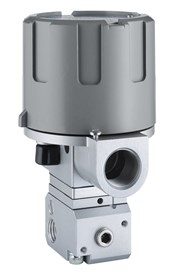IP26 Current to Pneumatic Signal Converter

The IP26 (current to pressure) transducer converts a4–20mA electrical current signal to a proportional linear pneumatic output. The unique conversion technology providesa high level of accuracy and repeatability for theoperation of actuated valves. A low masscontrol circuit provides consistent output in high vibration applications.This compact unit is housed in an explosion proof enclosurethat is designed for pipe, bracket or direct manifoldmounting. This explosion-proof and intrinsically safe field device is available with a built-in volume booster.
- Approvals Intrinsically Safe and Explosion Proof ATEX certification Ex ia IIC T6
- Enclosure IP 65
- Compact design, small size and low weight
- Position insensitive – Unit can be mounted in any plane and is stable in high vibration environments
- High air capacity
- Low input resistance, low power consumption
- Input signal 4 to 20 mA, 2-wire Loop powered
- Output signal by order
- 0.2 to 1 bar (3-15 psi) or
- 0.2 to 1.8 bar (3-27 psi) or
- 0.4 to 2 bar (6-30 psi)
- Temperature Limits -40 °C to 85 °C (-40 °F to 185 °F)
- Special version with Stainless Steel housing available
- For pipe, bracket or direct mounting
For conversion of a standard electrical signal into a standard pneumatic signal.
The IP26 (current to pressure) transducer converts a 4–20mA electrical current signal to a proportionally linear pneumatic output. The unique conversion technology provides a high level of accuracy and repeatability for the operation of actuated valves. A low mass control circuit provides consistent output in high vibration applications.
This compact unit is housed in an explosion proof enclosure that is designed for pipe, bracket or direct manifold
mounting. This explosion-proof and intrinsically safe field device is available with a built-in volume booster.
Para mas información vaya la solapa Documentacion en la parte superior de esta página
| Document title | Document type | Document Date | Download | |
|---|---|---|---|---|
|
FD-PSS-PO-06-EN
|
Specification guide | 01/09/2015 |

